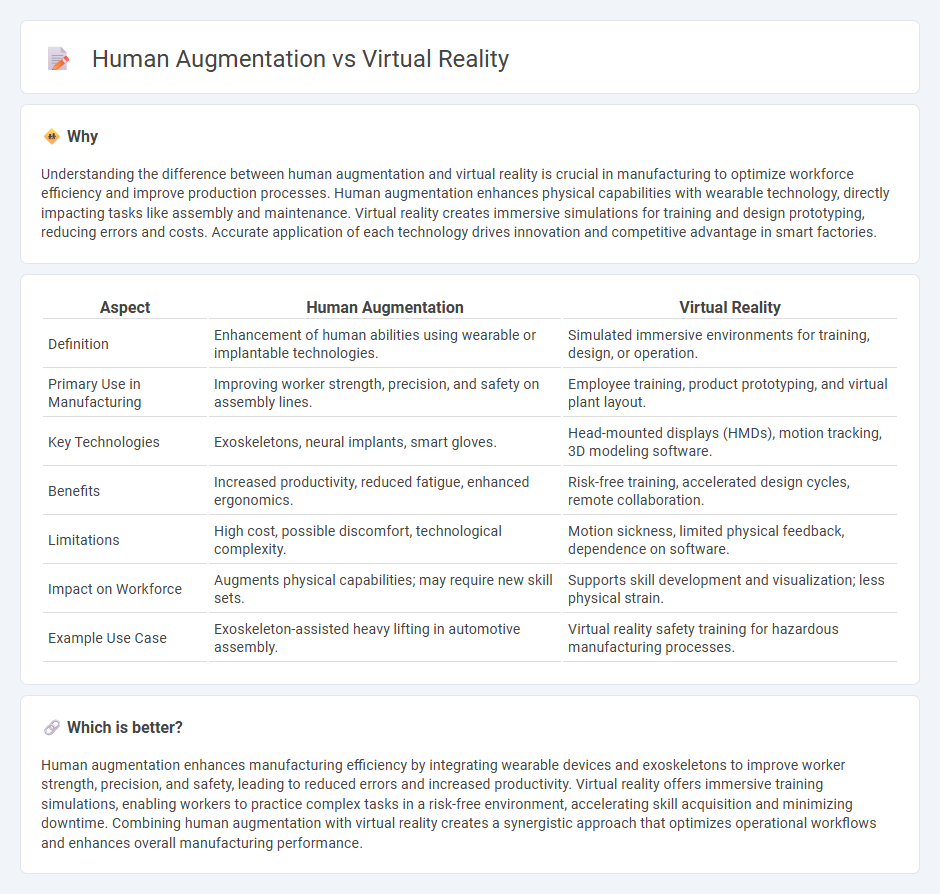
Human augmentation enhances manufacturing efficiency by integrating wearable devices and sensors that improve worker strength, precision, and safety. Virtual reality creates immersive training environments and enables virtual prototyping, reducing errors and accelerating design cycles. Explore how these technologies are transforming modern manufacturing processes.
Why it is important
Understanding the difference between human augmentation and virtual reality is crucial in manufacturing to optimize workforce efficiency and improve production processes. Human augmentation enhances physical capabilities with wearable technology, directly impacting tasks like assembly and maintenance. Virtual reality creates immersive simulations for training and design prototyping, reducing errors and costs. Accurate application of each technology drives innovation and competitive advantage in smart factories.
Comparison Table
| Aspect | Human Augmentation | Virtual Reality |
|---|---|---|
| Definition | Enhancement of human abilities using wearable or implantable technologies. | Simulated immersive environments for training, design, or operation. |
| Primary Use in Manufacturing | Improving worker strength, precision, and safety on assembly lines. | Employee training, product prototyping, and virtual plant layout. |
| Key Technologies | Exoskeletons, neural implants, smart gloves. | Head-mounted displays (HMDs), motion tracking, 3D modeling software. |
| Benefits | Increased productivity, reduced fatigue, enhanced ergonomics. | Risk-free training, accelerated design cycles, remote collaboration. |
| Limitations | High cost, possible discomfort, technological complexity. | Motion sickness, limited physical feedback, dependence on software. |
| Impact on Workforce | Augments physical capabilities; may require new skill sets. | Supports skill development and visualization; less physical strain. |
| Example Use Case | Exoskeleton-assisted heavy lifting in automotive assembly. | Virtual reality safety training for hazardous manufacturing processes. |
Which is better?
Human augmentation enhances manufacturing efficiency by integrating wearable devices and exoskeletons to improve worker strength, precision, and safety, leading to reduced errors and increased productivity. Virtual reality offers immersive training simulations, enabling workers to practice complex tasks in a risk-free environment, accelerating skill acquisition and minimizing downtime. Combining human augmentation with virtual reality creates a synergistic approach that optimizes operational workflows and enhances overall manufacturing performance.
Connection
Human augmentation enhances worker capabilities through wearable exoskeletons and sensor-equipped gloves, increasing precision and reducing fatigue in manufacturing environments. Virtual reality provides immersive training simulations and real-time assembly guidance, improving skill acquisition and error reduction on the production floor. Integrating augmented human performance with VR-driven instruction streamlines complex manufacturing processes and boosts overall operational efficiency.
Key Terms
Immersive Training
Immersive training using virtual reality (VR) creates fully simulated environments that enhance skill acquisition through experiential learning and repetitive practice without real-world risks. Human augmentation integrates wearable devices or neural interfaces to directly enhance cognitive and physical abilities during training, providing real-time feedback and adaptive assistance. Explore the unique benefits and applications of these technologies in transforming immersive training experiences.
Enhanced Ergonomics
Virtual reality (VR) offers immersive environments that improve ergonomics by reducing physical strain through customizable virtual workspaces, while human augmentation enhances the body's natural capabilities using wearable devices or implants to support posture and movement. VR primarily optimizes user interaction within a digital context, whereas human augmentation directly modifies or supports physiological functions for ergonomic benefits. Explore how these technologies revolutionize ergonomics in diverse industries by learning more about their unique applications.
Real-time Data Interaction
Virtual reality immerses users in a fully digital environment for interactive experiences, while human augmentation enhances real-time data interaction by integrating technology directly with human senses or cognition. Real-time data interaction in human augmentation allows seamless access and manipulation of live data streams through devices like augmented reality glasses or neural interfaces, optimizing performance and decision-making. Explore the latest advancements in real-time data interaction technologies and their impact on virtual reality and human augmentation.
Source and External Links
What is virtual reality (VR) and how does it work? - TeamViewer - Virtual reality (VR) simulates a realistic 3D environment through hardware like headsets and motion controllers combined with AI-driven software to create immersive, interactive digital worlds.
Virtual Reality, the technology of the future - Iberdrola - VR is a fast-growing technology projected to transform industries beyond entertainment, with advances such as wireless 8K headsets, AI integration, and 5G connectivity enabling real-time, highly immersive experiences.
What is Virtual Reality? - Virtual Reality Society - Virtual reality creates a computer-generated 3D environment explored using headsets and other devices, achieving a sense of presence by synchronizing sensory inputs to mimic real-life perception and avoid motion sickness.
 dowidth.com
dowidth.com